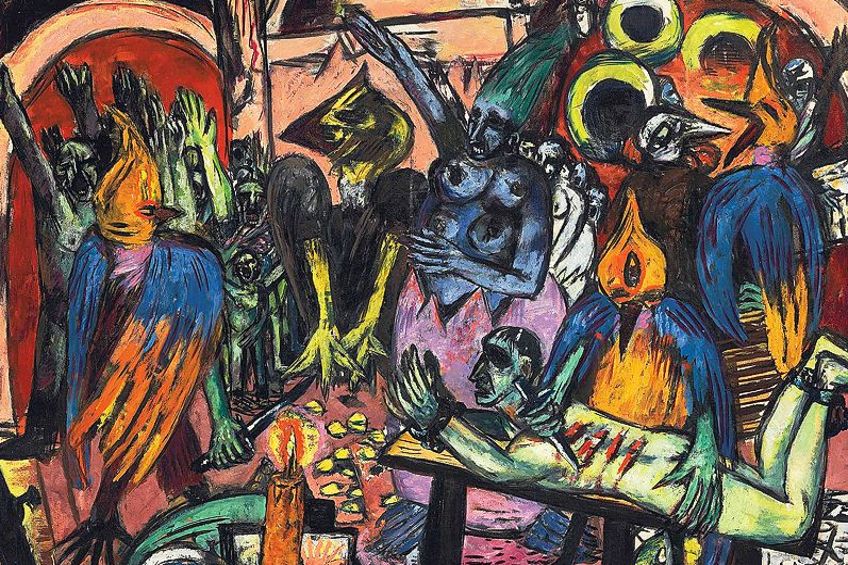Max Beckmann – Exploring the Style of Max Beckmann’s Paintings
Born Max Carl Friedrich Beckmann, he was a German artist who rejected the Expressionism movement in favor of the New Objectivity movement. This movement detested the emotional and romantic idealism of the Expressionists and instead, moved towards practicality in the world. In this article, we will learn more about Max Beckmann and his attempt to make sense of human existence and the turmoil of World Wars I and II through bold and figurative artworks.
Contents
A Max Beckmann Biography
Max Beckmann was a German artist who was mostly known for his ardent rejection of non-representational painting. Obsessed with the pursuit of true self-knowledge, Beckmann went on to create numerous important artworks throughout his artistic career. In the following section, there will be a detailed overview of Max Beckmann’s biography, his personal life, his education and career, and the art movements he was part of, was influenced by, and rejected.
| Date of Birth | 12 February 1884 |
| Date of Death | 27 December 1950 |
| Country of Birth | Germany |
| Art movements | New Objectivity and Expressionism |
| Genre/ Style | Moody style of painting with harsh black outlines. |
| Mediums Used | Painter, Draftsman, Printmaker, Sculptor, Writer |
| Dominant Themes | Figurative painting, Allegory of contemporary humanity, Terror, redemption and the mysteries of eternity and fate |
Personal Life
Max Beckmann grew up in Leipzig, Germany, as the youngest of three children. After his father died in 1894, his mother, Antoine Beckmann moved the family to Braunschweig, where they remained for years.
In 1906 he married his first wife, Minna Beckmann-Tube, who was also a fellow artist. In 1925 he divorced his first wife and married his second wife, Mathilde Q. Beckmann, who was an opera singer. In 1937, Beckmann and his second wife moved to Amsterdam in a self-imposed exile.
In 1950, shortly after Christmas, Max Beckmann suffered a heart attack while on his way to the Metropolitan Museum of Art to view his painting, Self-Portrait in Blue Jacket (1950). Unfortunately, this was the cause of his death.
Education and Career
Beckmann was put in boarding school, from which he ran away when he was just ten years old. He showed an early interest in the arts and has a self-portrait from when he was just a teenager in 1898. Also, in 1898 he applied to The Academy of Fine Arts in Dresden but was rejected.
In 1900 Beckmann entered the Weimar-Saxon Grand Ducal Art Academy and in 1902 he graduated with a diploma with honors. After graduation, he took a trip to France where he was influenced by some Impressionistic and post-Impressionistic paintings.
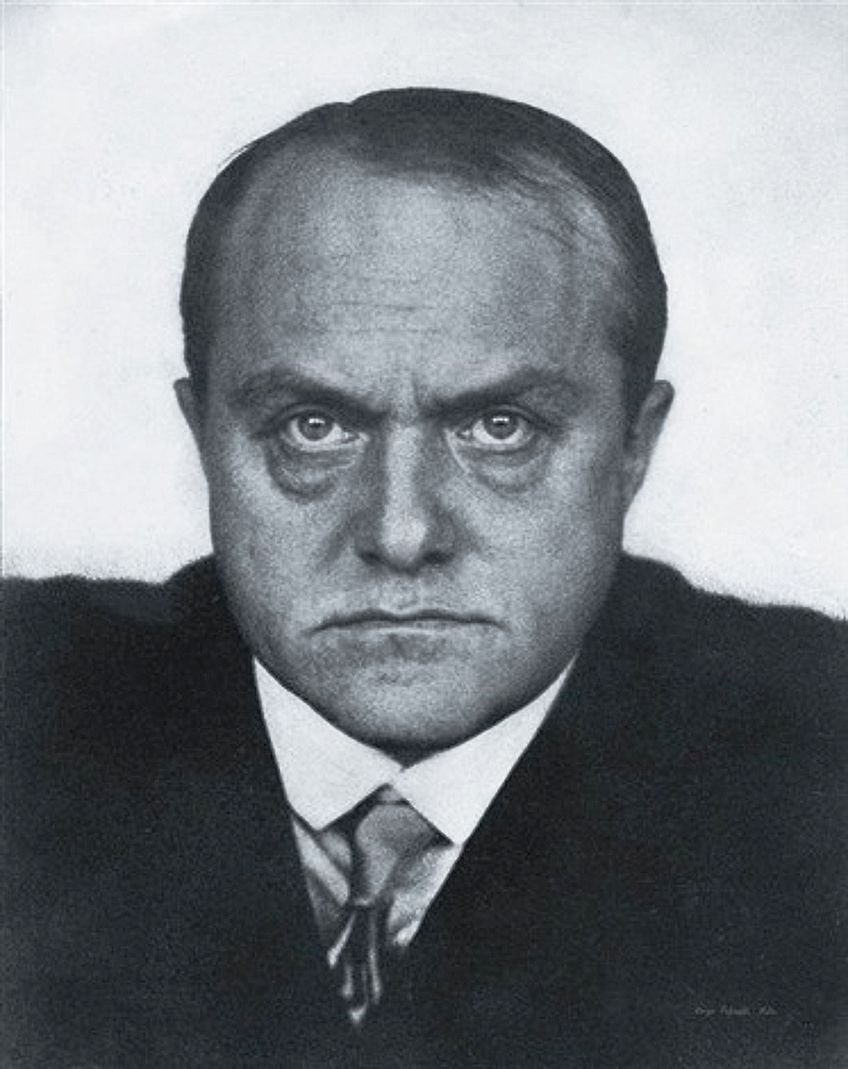
Beckmann received a reward for his painting Young Men at Sea (1905), which allowed him to travel to the Villa Romana in Florence where he was influenced by Expressionism and artists such as Vincent van Gogh and Edvard Munch.
In 1906 he begins a professional relationship with Paul Cassirer, an art dealer in the modern arts in Berlin. In 1913, Cassirer held a solo exhibition of Max Beckmann’s artwork. During that time, Beckmann positioned himself in direct opposition to the abstraction advocated by Franz Marc from Der Blaue Reiter.
Beckmann joined the army at the beginning of World War I in 1914, where he trained as a medical orderly. This occupation would go on to change his art forever. In 1915, after suffering a nervous breakdown, he was discharged from the army.

From there on his art was changed by the death and violence he witnessed during the war, which can be seen in his painting Adam and Eve (1917) through his use of heavy elongated lines and an extremely claustrophobic use of space.
He also started teaching at the Stadel Art School in Frankfurt and became more involved in the New Objectivity movement. Hitler coming to power made Beckmann receive a dismissal from his teaching job at the Stadel School, and Beckmann’s paintings were removed from all museums in Germany.
In 1947, years after he fled to Amsterdam, he received an offer for a teaching position at the School of Fine Arts at Washington University in St. Louis. He was later offered a job at the Brooklyn Museum Art School, which he accepted.
Art Movement: New Objectivity (Neue Sachlichkeit)
This was an art movement that arose in German art, literature, music, and architecture in the 1920s in reaction to the emotional idealism of Expressionism. The movement was named by Gustav Freidrich Hartlaub, who was the director of the Kunsthalle in Mannheim. He used the title to showcase post-Expressionistic artists.
These artists rejected the self-involvement and romantic longings of Expressionism, and instead worked towards public collaboration, engagement, and the rejection of the romantic idealism that Expressionism brought. In 1933, the movement ended with the rise of Nazi Germany.
Most Famous Paintings
As one of the leaders within the New Objectivity movement, Max Beckmann created incredibly unrestricted works that contrasted various themes. Below, we will be taking a closer look at some of Beckmann’s more well-known artworks.
Young Men by the Sea (1905)
| Date | 1905 |
| Medium | Oil on Canvas |
| Dimensions | 148 cm x 235 cm |
| Where it is currently housed | Schlossmuseum, Klassik Stiftung Weimar, Weimar |
Beckmann painted this painting when he was 21 years old, and his influence of post-Impressionistic artists can be seen coming through in this painting. The painting depicts six nude young men in the foreground, with four of them standing up and two sitting down. One of these men seems to be playing some form of musical instrument. Other figures in the background are also thought to be playing and swimming.
The men in the foreground are depicted in several different poses and, therefore, give off the resemblance of an anatomical study. The beach, with the sea and clouds in the background, shows the academic training of Beckmann and his interest in post-Impressionistic landscapes.
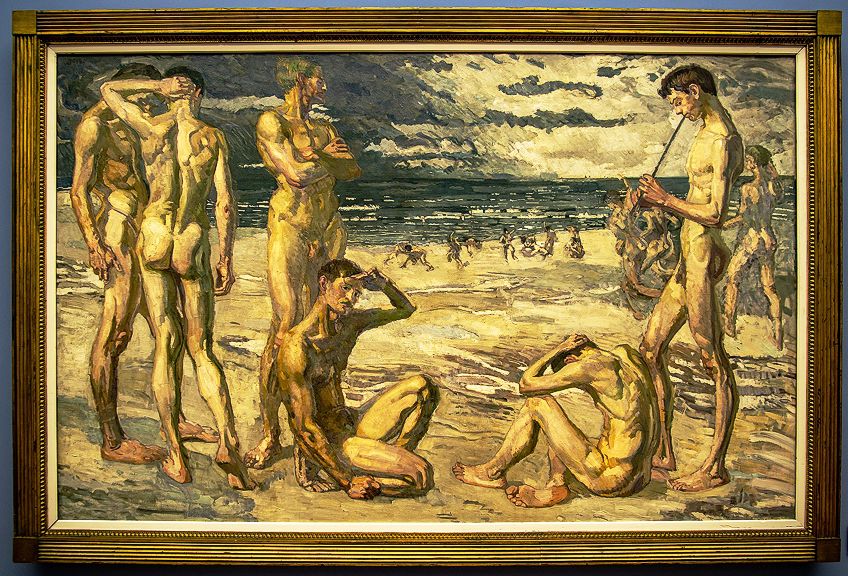
Adam and Eve (1917)
| Date | 1917 |
| Medium | Oil on Canvas; lithograph |
| Dimensions | 57 cm x 80 cm |
| Where it is currently housed | Staatliche Museen zu Berlin, Nationalgalerie |
There exists a painting called Adam and Eve, as well as some other lithographs with the same name by Max Beckmann. This was the first piece of art that Beckmann made after his nervous breakdown in the army, which adds to the importance of the work.
These are the pieces that demonstrate how his art changed prior to and after the war, with this change being incredibly drastic.

Self-Portrait in Tuxedo (1927)
| Date | 1927 |
| Medium | Oil on Canvas |
| Dimensions | 139.5 cm x 95.5 cm |
| Where it is currently housed | Busch Reisinger Museum, Harvard University |
This painting depicts Beckmann in a typical 1920s suite, standing with his hand on his hip and holding a cigarette in his left hand over his stomach area. He is standing in front of a white wall and to the left of his figure, is a doorway. He has a neutral expression on his face and looks directly at the viewer.
Even with the white wall, the painting gives off an incredibly dark and moody atmosphere.
His face is seen under symmetrical shadows and lights, with his pose reminding the viewer of the heroic poses of statues. His hand in the foreground is well lit and form a contrast to the dark background of the doorway, while balancing out the white wall background. The black, white, and brown colors give off a clean feeling.
The initial critical receptions to this painting were mixed.
Quappi in a Pink Jumper (1932 – 1934)
| Date | 1932 – 1934 |
| Medium | Oil on canvas |
| Dimensions | 105 cm x 73 cm |
| Where it is currently housed | Thyssen-Bornemisza Museum, Madrid |
Beckmann painted his second wife, Mathilde von Kaulbach, also known as Quappi, in this painting. She is sitting at an angle and looking slightly to her left, while holding a cigarette in her right hand. She appears to be relaxed, and sits with her legs crossed. She is wearing a light pink jumper with a matching pink handkerchief and a plain brown skirt. The background is a matching pink wall with some blue texture on it and a dark doorway with light stripes coming through. She is sitting on a teal blue couch that compliments all the pinks in the painting well.
In this painting, he did not use the harsh black outline as he used to in previous paintings, but rather made her look beautiful and elegant.
He started this painting in 1932 but changed her facial features to make her less smiling to reflect their concerns of the Nazi rise to power. He then finished the painting in 1934 and changed the date of the painting.
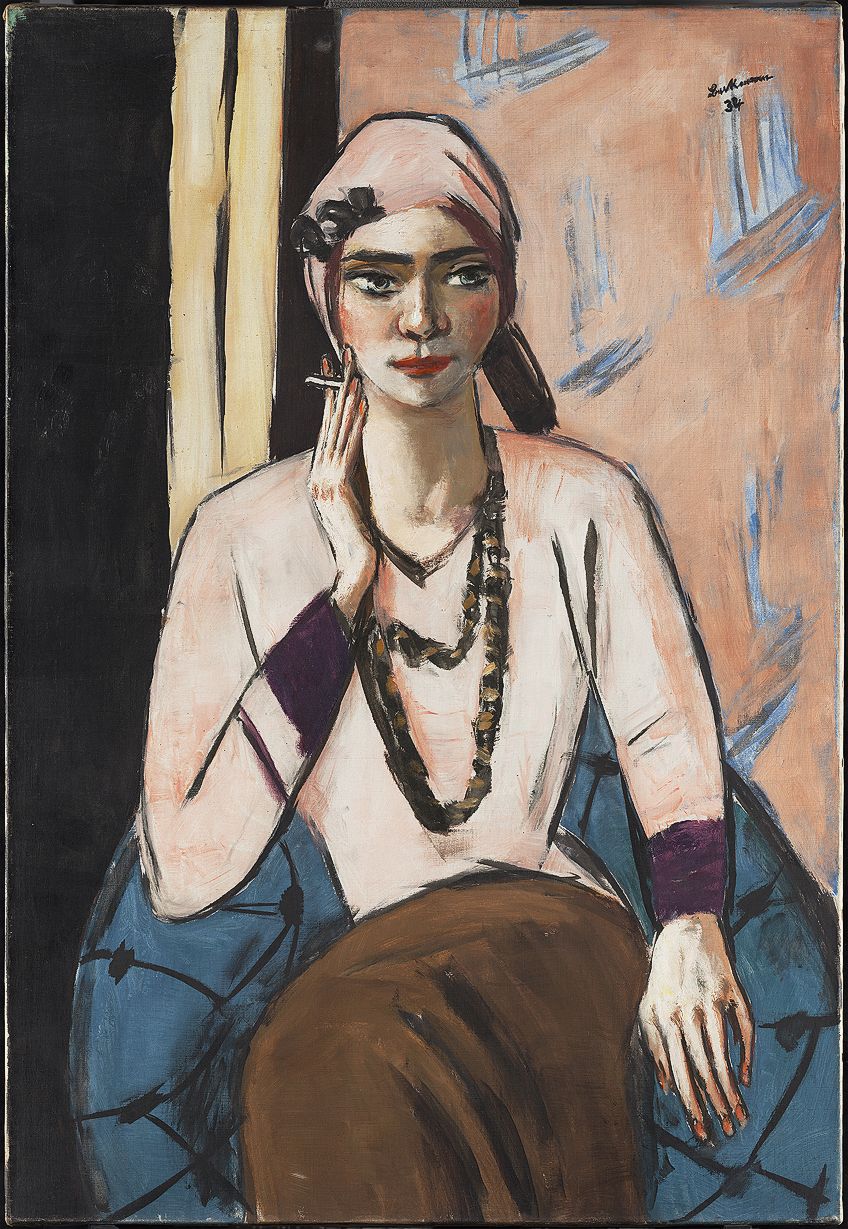
Magic Mirror (Zauberspiegel) from Day and Dream (1946)
| Date | 1946 |
| Medium | Lithograph; graphite |
| Dimensions | 30.7 cm x 21.9 cm |
| Where it is currently housed | MoMA Gallery, Manhattan |
This sketch depicts a tiny woman in a long gown standing on top of a table and looking through an open window. The shadow of the open window is what looks like a painting of men glancing at the woman. In this series, he depicts everyday subjects that he has depicted in his artwork before.
This was done in order to demonstrate that nothing really changes, and that everything is just a repetition of itself.

The Argonauts (1949 – 1950)
| Date | 1949 – 1950 |
| Medium | Oil on canvas |
| Dimensions | Unknown |
| Where it is currently housed | National Gallery of Art, Washington D.C. |
The left panel depicts an almost nude woman holding a sword, meant to be Madea, looking over at an artist painting on a canvas. The woman is sitting on a sculpture of a head, and is sitting next to a plant. It seems as if the artist is painting the woman from life. This is one of three panels, as the right panel depicts music, and the middle panel depicts poetry. Beckmann wanted to call the three panels “The Artists” but decided to name it The Argonauts instead.
This is the last painting that Beckmann ever completed.
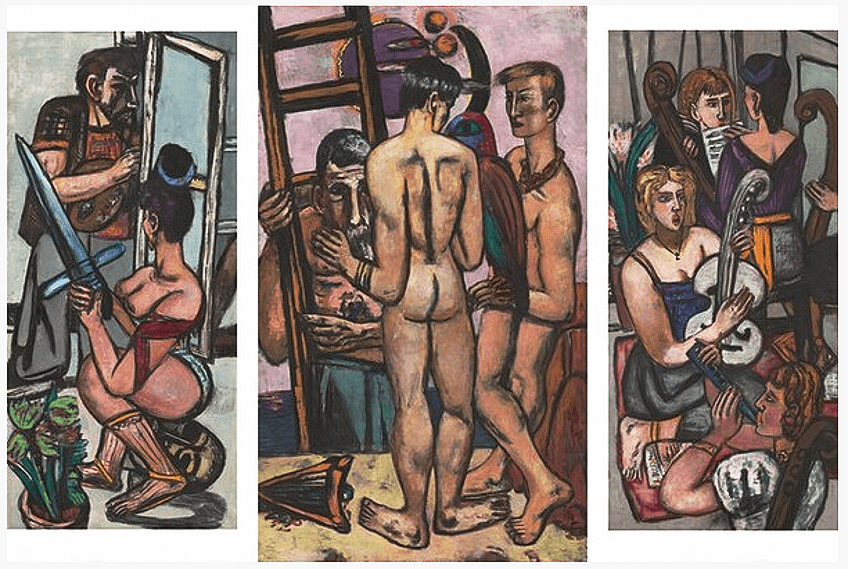
Self-Portrait in Blue Jacket (1950)
| Date | 1950 |
| Medium | Oil on canvas |
| Dimensions | 140 cm x 91.4 cm |
| Where it is currently housed | St. Louis Art Museum |
This figure is leaning against a piece of furniture while holding a cigarette between two fingers up to his lips. He is absentmindedly looking to the right of the composition, as if deep in thought. He is wearing a bright blue jacket with an orange shirt underneath, along with a neutral tie. The figure has his other hand in the pocket of his pants. In the background is a warm-toned wall and a darker strip of color, most likely a doorway.
This was the painting that Beckmann was on his way to go look at in a museum when he passed away from a sudden heart attack. This worl was his last self-portrait to ever be painted.

Important Exhibitions
Beckmann’s first exhibition with the Berlin Secession happened in 1906. They were a group founded by young, modernistic artists to counter the conservative art industry, run by the state. Throughout the 1920s, Max Beckmann’s artwork was seen regularly in exhibitions in Germany and throughout Europe, including the large retrospective at the Stadtische Kunsthalle in Mannheim in 1928. By that time, he also had at least two exhibitions in the United States of America, including in New York.
After his death, the Saint Louis Art Museum, which owns the biggest public collection of Max Beckmann paintings in the world, put on a massive exhibition of his artwork. Except for a few smaller exhibitions, Max Beckmann’s artwork was not often seen in the United States.
The Legacy of Max Beckmann
A lesson Max Beckmann seemed to try to get across to his students was that of the importance of personal narrative. Artists influenced by Beckmann were his fellow New Objective colleagues like George Grosz and Otto Dix. He also influenced his other students, such as Ellsworth Kelly, despite their stylistic differences. Portraitists during the late 20th century that encountered his work were also influenced by his style and message.
Max Beckmann’s artwork had a profound influence on Boston Expressionism, a movement that would later be known as American Figurative Expressionism.
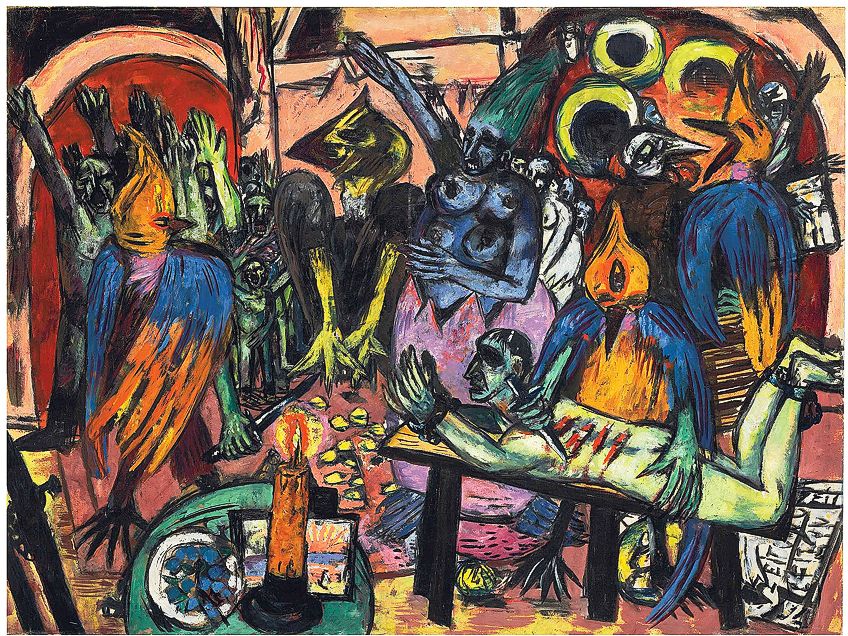
He influenced artists like Philip Guston and Nathan Oliveira. In the late 20th century, Max Beckmann’s artwork has gained a higher reputation internationally. There have been more retrospectives and exhibitions all over Europe, with a notably large permanent exhibition in Frankfurt at the Städel, who devoted an entire room to Max Beckmann.
In 1996, Beckmann’s publisher released the last volume of his letters. His diaries, plays, and other documentation such as essays are also unique historical documents. In 2003 a Parisian novelist and art historian published Max Beckmann’s biography, though it is not yet translated into English.
Suggested Reading
Below are a few books about the life and art of Max Beckmann for further reading if you are interested in finding out more about this artist. Some books are even written by the artist himself. Some books are of his paintings, while some are more of a biography of sorts.
Max Beckmann: Exile Figures (2019) by Max Beckmann
This hardcover book is a comprehensive study of Max Beckmann’s artwork throughout his life and combines more than 60 of his best artworks. This book also studies several themes of exile and alienation of the artist in a post-war reality. This book is written by the artist, Max Beckmann.
- Offers a full overview of Beckmann's personal life and artistic career
- Explores more than 60 of Beckmann's paintings, lithographs, and sculptures
- An interpretation of Beckmann's career through various metaphors (like exile)
Max Beckmann in New York (2016) by Sabine Rewald
This hardcover book captures Max Beckmann’s artworks during the later years of his life while living in New York. These are artworks made by Beckmann while teaching art. He eventually passed away in New York after finishing his last artwork, Argonauts.
- An up-close and personal look at the life and work of a major 20th-century artist
- Focuses on the works produced by Beckmann in the final years of his career
- Features beautiful reproductions of Beckmann's remarkable artworks
Max Beckmann at the Saint Louis Art Museum: The Paintings (2015) by Lynette Roth
This hardcover book is a collection of Max Beckmann paintings and artwork exhibited at the Saint Louis Art Museum, the largest public collection of his artwork. This book examines all 39 paintings exhibited in the museum’s collection.
- Richly illustrated and filled with detailed information about the artist
- Features fascinating insights into both Beckmann's personal life and art
- An exploration of the Saint Louis Art Museum's collection of Beckmann paintings
Max Beckmann: On My Painting (Artist’s Writings) (2013) by Max Beckmann
This Kindle edition book is part of a series of five books called Artist’s Writings, written by Max Beckmann himself. This book can give valuable insight into the understanding of his paintings. It was composed in 1938, a year after he was included in the Degenerate Art exhibition put on by the Nazis.
- Introduction written by Beckmann's granddaughter, Mayen Beckmann
- Insightful overview about Beckmann's life and artistic career
- Formatted for the Kindle Edition
Today, Max Beckmann’s achievements within the art world are firmly associated with his work in both the New Objectivity and Expressionism movement. Becoming one of the preliminary artists within the New Objectivity, Beckmann went on to create impressive artworks that existed as harsh analyses of the interwar period that he found himself in. If you have enjoyed reading our Max Beckmann biography and learning about this artist, we encourage you to research further!
Frequently Asked Questions
What Technique Did Max Beckmann Use?
As a painter, Max Beckmann generally preferred using oil on canvas. All of his most famous artworks were made using oil on canvas. In addition to being a painter, Beckmann was also a draftsman, printmaker, sculptor, and writer.
Is Max Beckmann Still Alive?
While his artwork is still spoken about and admired, Max Beckmann is no longer alive today. He sadly passed away on 27 December 1950 in New York City, United States, after suffering from a heart attack.
What is Max Beckmann Known For?
He is famous for using harsh black outlines and rejecting the romantic idealism of the Expressionists. He used oil on canvas for painting, with his drawings being done using graphite. He is also known for using a claustrophobic perspective in his use of space. Beckmann is also known for his numeral self-portraits throughout his life, made in many different styles as he grew as an artist.
What Did Max Beckmann Make Paintings Of?
He made lots of self-portraits and was also a portraiture artist. He was influenced by post-Impressionism and that showed through in his landscapes and backgrounds.
When Did Max Beckmann Leave Germany?
Max Beckmann moved to Amsterdam in 1933, after the Nazi government came into power. Because of this, he lost his teaching position.
Jordan Anthony is a Cape Town-based film photographer, curator, and arts writer. She holds a Bachelor of Art in Fine Arts from the University of the Witwatersrand, Johannesburg, where she explored themes like healing, identity, dreams, and intuitive creation in her Contemporary art practice. Jordan has collaborated with various local art institutions, including the KZNSA Gallery in Durban, the Turbine Art Fair, and the Wits Art Museum. Her photography focuses on abstract color manipulations, portraiture, candid shots, and urban landscapes. She’s intrigued by philosophy, memory, and esotericism, drawing inspiration from Surrealism, Fluxus, and ancient civilizations, as well as childhood influences and found objects. Jordan is working for artfilemagazine since 2022 and writes blog posts about art history and photography.
Learn more about Jordan Anthony and about us.
Cite this Article
Jordan, Anthony, “Max Beckmann – Exploring the Style of Max Beckmann’s Paintings.” artfilemagazine – Your Online Art Source. February 24, 2022. URL: https://artfilemagazine.com/max-beckmann/
Anthony, J. (2022, 24 February). Max Beckmann – Exploring the Style of Max Beckmann’s Paintings. artfilemagazine – Your Online Art Source. https://artfilemagazine.com/max-beckmann/
Anthony, Jordan. “Max Beckmann – Exploring the Style of Max Beckmann’s Paintings.” artfilemagazine – Your Online Art Source, February 24, 2022. https://artfilemagazine.com/max-beckmann/.


